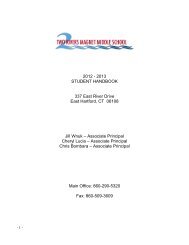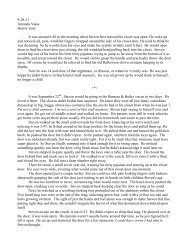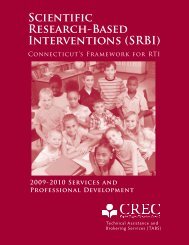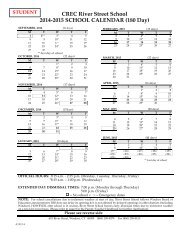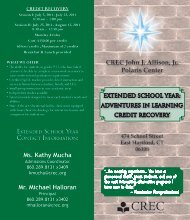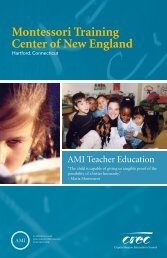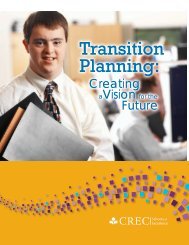Reading and Role Playing: Fiction, Folktales, and Fairy Tale
Reading and Role Playing: Fiction, Folktales, and Fairy Tale
Reading and Role Playing: Fiction, Folktales, and Fairy Tale
Create successful ePaper yourself
Turn your PDF publications into a flip-book with our unique Google optimized e-Paper software.
<strong>Reading</strong> Curricular Calendar, Second Grade, 2012-201310Will she win or will she lose? Children can pay attention to the pattern, <strong>and</strong> ask <strong>and</strong> answer,“Why is this happening? What will happen next?” They can also think about whether a characteris the one who is teaching a lesson or learning one. You’ll return to this in greater detail in thefinal bend of the unit. For now, it’s enough to nudge children to read with an eye toward it.Now is the perfect time to spotlight the antecedents of the character types they will encounter intheir modern-day stories—fairy tales, folktales, <strong>and</strong> fables. These short moralistic tales areparticularly powerful teaching texts in part because they feature characters who have such clearlydefined, often exaggerated traits. Children will have an easy time identifying the good guy <strong>and</strong>the bad guy in these stories—<strong>and</strong> eventually, other archetypes too. These tales are full of drama,so when you read them aloud—as we suggest you do—be sure to throw some gestures into yourperformance <strong>and</strong> give characters distinguishable voices to spotlight the role each one plays.Cackle <strong>and</strong> act crotchety as the wicked old witch, make your voice light <strong>and</strong> sweet when you arethe hero or the heroine. Meanwhile, encourage your kids to ham it up too as they step into theseroles. “Fee, Fi, Fo, Fum!” dem<strong>and</strong>s to be spoken in a loud, mean voice. “Mirror, Mirror on thewall, who’s the fairest of them all?” will sound more cunning <strong>and</strong> coy—<strong>and</strong> will have a singsongquality. <strong>Fairy</strong> tales <strong>and</strong> folktales (which originated as oral stories) are full of repetitive chantsthat students will love to perform. Meanwhile, these repeated lines “supply rhythm <strong>and</strong> meaningin a story...” (CCSS RL 2.4).There’s another reason to introduce fairy tales <strong>and</strong> folktales at this stage in the unit. Your secondgrade readers are nearing the end of the grade, <strong>and</strong> not one but two of the Common Core’sexpectations of second graders touch on the ability to read—<strong>and</strong> dissect—these old tales.Specifically, the St<strong>and</strong>ards expect that second graders will be able to “recount stories, includingfables <strong>and</strong> folktales from diverse cultures, <strong>and</strong> determine their central message, lesson, or moral”<strong>and</strong> “compare <strong>and</strong> contrast two or more versions of the same story (e.g., Cinderella stories) bydifferent authors or from different cultures.” This means that beyond simply enjoying the drama<strong>and</strong> aurally pleasing nature of these tales, your students will need to read them critically, thinkingacross messages, across authorial intent—that is, they will need to do some sophisticatedthinking work. You’ll therefore want to angle your instruction so that from the start, childrennotice the elements these tales were intended to convey.For example, after children have heard several tales, they may start to notice that the books theyhave been reading have similar characters—a bad wolf, a wise old man, an evil step relation—<strong>and</strong> that these characters have similar traits. The wise old man has all the answers but makes themain character work to get them; the stepmother in these tales is often evil <strong>and</strong> goes out of herway to harm the heroine. Readers may also notice that these archetypes sometimes differsomewhat from story to story. For example, the wolf in Little Red Riding Hood <strong>and</strong> The ThreeLittle Pigs is the villain in both stories, but the wolf in the first story seems smarter than the wolfin the latter. This is the perfect opportunity for you to teach children that fairy tales <strong>and</strong> folktalesare archetypes for modern stories, that characters who play similar roles will pop up again <strong>and</strong>again, not only in these old tales but in more modern stories, too. Children might say, “Instead ofa wolf, this book has a mean old dragon! Reminds me a little bit of Mean Jean the RecessQueen.” The hope is that children take note of not just the magic in fairy tales <strong>and</strong> folktales(though of course, that’s part of the fun!), but also the ways in which archetypes from thesegenres repeat themselves over <strong>and</strong> over in modern literature, albeit in non magical forms. This isUnit Six – <strong>Reading</strong> <strong>and</strong> <strong>Role</strong> <strong>Playing</strong>: <strong>Fiction</strong>, <strong>Folktales</strong>, <strong>and</strong> <strong>Fairy</strong> <strong>Tale</strong>s<strong>Reading</strong> <strong>and</strong> Writing Project, 2012 ©DRAFT




